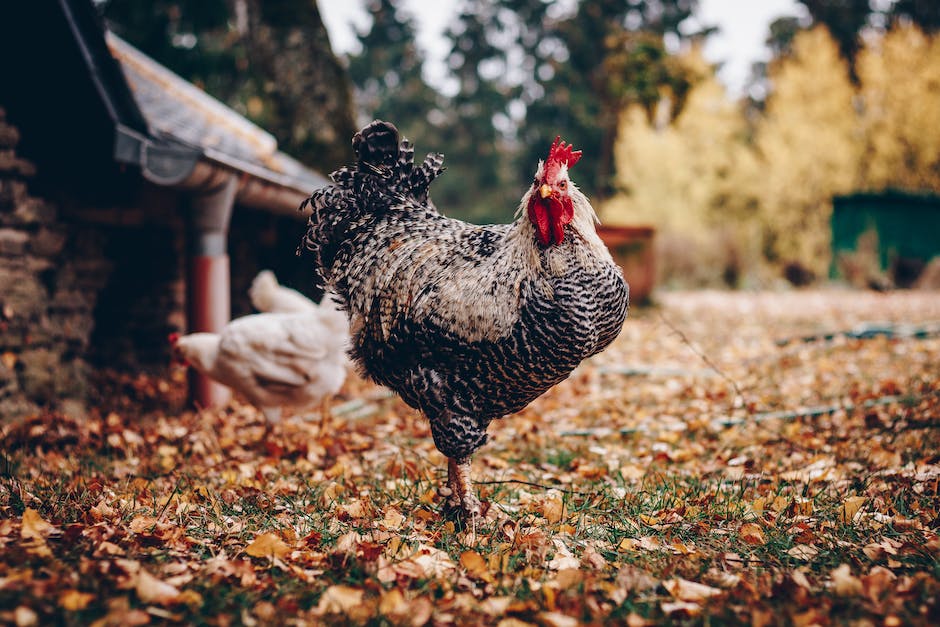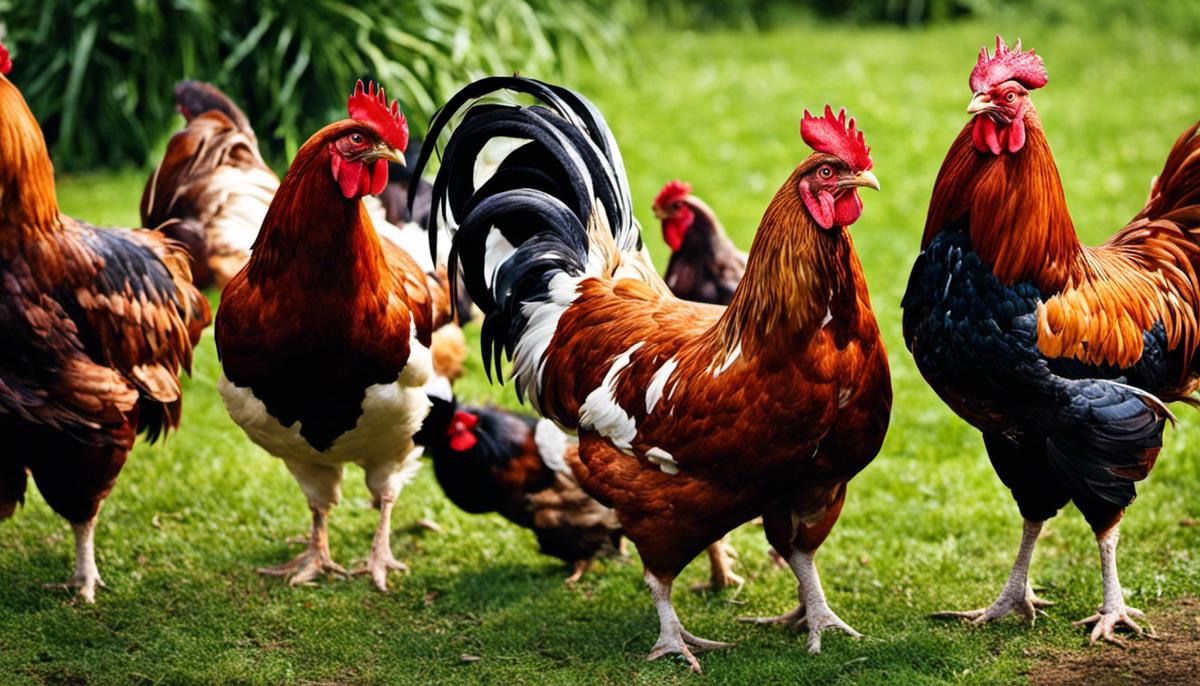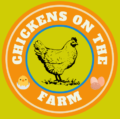We will receive a commission if you make a purchase through our affiliate link at no extra cost to you. Please read our disclosure policy for more information.
If you’ve ever found yourself gazing at a flock of chickens, you’re likely to have wondered how to distinguish between roosters and hens. Many may think that it is a simple task, but the truth is that telling them apart can be a little tricky if you’re not aware of what to look out for. This task necessitates a keen understanding of some distinct characteristics and profound observational skills. Firstly, it requires an understanding of the physical differences, such as variations in size, unique feather coloration, and pattern, as well as, differences in the size and color of the comb and wattles.
Secondly, it calls for an examination of different behavioral patterns; roosters usually exhibit more aggression and a different set of guarding behaviors than hens. Lastly, assessing vocal differences is crucial. While a rooster’s crow is common knowledge, there’s often more to the clucking symphony than meets the ear; hens also have their signature sounds.
Understanding the Physical Differences
As seasoned poultry hobbyists, there’s an irresistible charm to exploring the nuanced world of chicken-keeping. It’s an interesting field that offers unlimited scope for learning, especially when you dive into understanding the fascinating physical distinctions between hens and roosters. In this article, crucial pointers are highlighted that will help you differentiate between the two, enabling you to run your poultry farm efficiently or simply providing a deeper understanding of the feathered buddies you might have around!

-
Size and Build:
The first noticeable difference lies in the physical stature. The rooster typically stands taller than the hen with a robust build. The hen, on the other hand, is smaller in stature and less physically imposing. This difference is primarily classified by their roles in nature – the rooster is the defence champion, warding off threats, while the hen is nimble, making for a perfect egg carer.
-
Combs and Wattles:
A key identifier lies in the size and shape of combs (the crest atop their head) and wattles (the hanging lobes beneath their beak). Roosters generally sport a larger, more distinct comb and wattles, both of which are noticeably brighter and plumper comparing to hens, as they serve as a visual cue in the mating game.
-
Tail Feathers:
An eyes-on look at their tail feathers, and you’ll be able to identify who’s who. Rooster tail feathers are flamboyant, long, and curved, often boasting iridescent colors. Hens usually have shorter, less conspicuous tail feathers -agreed, less theatrical than their male counterparts yet modestly attractive!
-
Hackle Feathers:
Observed around the neck area, the hackle feathers of roosters are pointed and long, whereas hens exhibit a rounder, fuller feather design. A meticulous examination might be needed here, but if you truly appreciate these delightful birds, it’ll be a discovery worth making!
-
Spurs:
As you develop familiarity, the spur – the claw-like growth on the inner side of each leg – will be an accurate pointer. Yes, hens may develop spurs too, however, they usually are smaller and less pointed compared to the longer, sharper spurs of a mature rooster.
-
Crow:
Though it’s not a physical attribute, the crow of the rooster is a giveaway in this detective game. Although exceptions exist, generally, only roosters will deliver that unmistakable, robust, early morning wake-up call!
Remember, early identification of roosters and hens is crucial in the world of poultry farming or even casual backyard chicken-keeping. Whether it’s for breeding, egg-production, or simply maintaining the peace in your flock, these physical differences guide you towards a successful flock management strategy or a stronger bond with those feathery friends.
The joy of exploring the world of chickens lies in the observational journey, understanding their unique traits, and seeing them thrive. Happy chicken observing, dear poultry enthusiasts!

Photo by davidclode on Unsplash
Observing Behavioral Differences
Let us now venture a little deeper into the fascinating world of poultry farming. Having already explored the physical differences between hens and roosters, let’s focus on some not-so-obvious aspects that are just as crucial for optimal flock management. These include behavioral differences, egg-production, breeding, and the overall contribution to a flourishing, harmonious poultry environment. Indeed, poultry farming is not just about identifying physical attributes; it’s an endless adventure of knowledge where each day brings a new revelation.
First, recognize the behavioral differences: Understanding behavior patterns is vital in managing your flock. One commonly noted behavioral difference is that roosters are typically more aggressive and dominant. They exhibit protective instinct, guarding the flock from predators. Hens, on the other hand, tend to be docile and show nesting behaviors, especially when they’re broody.
Second, pay attention to egg-production: Hens play a significant role in egg production, which is a critical factor in either commercial poultry farming or self-sufficiency efforts. Roosters, however, do not lay eggs. Hens start laying eggs from around five months of age while roosters mature a bit later. Noting this fact can be surprisingly supportive in farm planning.
Breeding
Next, let’s talk about breeding: Roosters are crucial in the breeding process. Breed sustainability depends entirely on roosters as they fertilize the eggs. This critical feature can’t be overlooked, especially for those aiming to expand their flocks.
Lastly, contribution to a harmonious environment: Roosters act as watchmen, alerting the flock to potential threats. They also find and call hens to food, which is a charmingly protective behaviour. Conversely, hens create a calm environment by engaging in regular feeding, nesting, and communal activities. Understanding these roles will definitely contribute to a flourishing, harmonious poultry environment.
Indeed, by studying and understanding these factors, you can take your poultry farming or backyard chicken-keeping skills up a notch. The hobby turns into a passion, and every day at the farm becomes a fulfilling experience. After all, successful poultry farming isn’t just about maintaining a flock. It’s about understanding and appreciating these wondrous creatures, and getting involved in their world! Raise a glass to the on-going journey of understanding your feathered friends better. Happy Poultry Farming!
Learn more about choosing your ideal breed for your chicken farm: Click Here

Assessing Vocal Differences
Having navigated the physical distinctions between hens and roosters, and explored their unique behaviors, it’s time we dive into unwrapping the vocal differences that exist between these fascinating creatures.
In essence, the vitality of roosters’ and hens’ vocalization is part of the enchantment of raising poultry. These expressive outbursts not only embellish our understanding but serves as a key tool for flock communication, maintenance, and survival.
Starting off with our roosters, anyone who has ever encountered one will forever remember their infamous crow. It is an unmistakable sound, typically lasting for about five seconds and ending on a high note. This crowing isn’t just a melodious morning alarm but is often used to assert dominance within the flock or to express heightened emotion. Remember, the crowing could range anytime during the day and is not solely restricted to sunrise.
Hens
Moving on to hens, their vocal repertoire is surprisingly vast! From soft clucking and purring to signal contentment, to squawking during instances of distress or danger, hens tend to be more vocally intricate than roosters. Furthermore, many admire their ‘egg-song,’ a charming and triumphant series of clucks celebrating their latest egg laying accomplishment.
Notably, a quick way to differentiate between these seemingly similar sounds is their pitch and volume – rooster crows are typically louder and have a sharper tone, while hens vocalizations tend to be softer and more melodious.
Another distinguishing feature is the frequency of vocalization. Hens are generally more talkative and express a wider array of emotions through their sounds than roosters. Unlike roosters crowing primarily for dominance, hens employ their vocabulary for a multitude of purposes, including laying, nesting, brooding, or feeding. For your ultimate guide to raising chickens: Click Here
In conclusion
Understanding these intricate distinctions is the essence of successful poultry farming. It isn’t just about acknowledging these differences but gaining a deeper appreciation for the complex dialogues taking place every day within our flocks. So the next time there’s an outburst from your backyard coop, remember – each crow, cluck, and squawk is all part of the language of poultry. So, it’s time to listen, learn, and engage in this wonderful world of sounds.

We now understand that differentiating a rooster from a hen requires a mix of a keen eye for physical disparity, understanding of behavioral variance, and a tune to distinctive vocal signals. They all play a significant role in effectively separating one from the other. The physical attributes, such as size, feather pattern, or the comb’s size and color, often provide an immediate clue. However, dig a bit deeper, and behavioral traits such as their guarding tendencies and aggression levels can give a more accurate image. Lastly, paying attention to vocal communications, from the famous rooster’s crow to a hen’s soft and subtle cluck, will offer an indelible insight into the socio-dynamic structuring of poultry. When you marry this information, determining the sex of an adult chicken would prove no higher than a mere stroll in the park.

